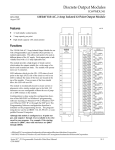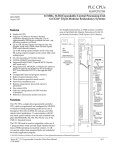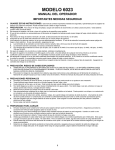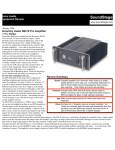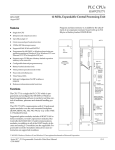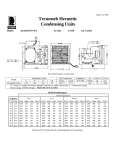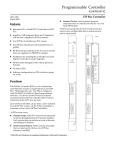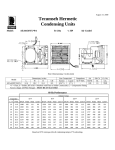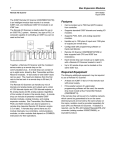Download Series 90-70 Programmable Controller Data Sheet Manual, GFK
Transcript
1 Discrete Output Modules IC697MDL940 56 Relay Output, 16 Point Module GFK-0384E August 1997 ]]]Relay Output, 16 Point Module (IC697MDL940) datasheet GFK-0384E Features a44323 D 16 points - 8 isolated Form C - 2 groups of 4 Form A D D D D A1 A2 A3 A4 A5 A6 A7 A8 2 amp per point switching capacity RC snubber and fuse protection per point No user power required B1 B2 B3 B4 B5 B6 B7 B8 C1 C2 C3 C4 C5 C6 C7 C8 FUSE Removable field wiring terminal OUTPUT RELAY, 16PT 2A PILOT DUTY 16A MAX/MODULE A1 Functions The 16 point Relay Output Module is versatile, rugged, and easy to use. It will switch a variety of low to medium power loads such as relays, contactors, and lamps. The resistive rating of the module is 2 amps per point at 120/240 VAC or 24 VDC and 0.2 amps per point for 125 VDC. Power to energize the relay coils is supplied by the module and each output is individually fused and suppressed with an RC snubber. A2 A3 A4 B1 B2 B3 B4 LED indicators which display the ON - OFF status of each point on the logic (PLC) side of the circuit are located at the top of the module. C1 Field wiring is made to a removable terminal board and the module is mechanically keyed to ensure correct replacement with a similar module type in the field. I/O references are user configurable without the use of jumpers or DIP switches on the module. C3 C2 C4 D1 D2 Configuration is done using the configuration function of the MS-DOSr or Windowsrprogramming software running on Windowsr 95 or Windows NTr over Ethernet TCP/IP or through the SNP port. The Programming Software configuration function is installed on the programming device. The programming device can be an IBMr XT, AT,PS/2r or compatible Personal Computer. D3 D4 SLOT Î Î Î Î Î Î Î Î Î Î Î Î Î Î Î Î Î Î Î Î Î Î Î Î Î Î ÎÎ Î D1 D2 D3 D4 D5 D6 D7 D8 A1 A2 A3 A4 A5 A6 A7 A8 C1 B1 C2 B2 C3 B3 C4 B4 C5 B5 C6 B6 C7 B7 C8 B8 FUSE D1 D2 D3 D4 D5 D6 D7 D8 24-240VAC 50/60HZ 5-125VDC 480VA, 60 WATT NO A1 1 V 2 3 NC A1 NO 4 5 6 7 A2 V NC NO A3 NC A3 A2 V 8 9 NO 10 11 A4 V NC 12 A4 13 NO 14 15 B1 V 17 NC NO B2 19 NC B2 16 B1 18 V NO 20 21 22 23 B3 V NC NO B3 B4 24 V 25 NC B4 26 27 NO 28 29 NO 31 NO NO 30 C1 C2 C3 C4 32 V 33 34 35 NO 36 38 NO 37 NO NO D1 D2 D3 D4 39 40 V MODULE IC697MDL940 LABEL 44A726758-016RO3 r IBM and PS/2 are registered trademarks of International Business Machines Corporation. r MS-DOS, Windows, Windows 95, and Windows NT are registered trademarks of Microsoft Corporation. t Series 90 -70 Programmable Controller Data Sheet Manual GFK-0600F 56-1 Discrete Output Modules 2 GFK-0384E August 1997 Relay Output, 16 Point Module Operation - Relay Output Module a44515 LED FORM C RELAY RELAY DRIVER BACKPLANE SNUBBER FORM A RELAY V FUSE 3A SYSTEM INTERFACE RELAY DRIVER Î ÎÎ NO SNUBBER Î ÎÎ Î ÎÎ NC NO FUSE 3A V LED Figure 1. Block Diagram for IC697MDL940 Output Protection For more detailed information on module configuration, refer to the Programming Software User’s Manual. Fusing Each output is protected with a 3 amp fuse. Replace with either of the following types: D 3AG - 3.0 amp, 250V, Fast Acting D Metric 5 x 20 mm - 3.0 amp, 250V, Fast Acting Suppression Each output is suppressed with an RC snubber to reduce high frequency noise transients on the board. Proper suppression of the switched load is still recommended and will contribute to improved system reliability. Suppression at the load will not only lengthen contact life, but will also reduce noise transients in the control wiring. Fault Mode Selection This output module can be configured from the programmer so that output points assume one of two states in response to certain operating or default conditions. These states are: D Maintain existing output state D Turn outputs OFF 56-2 Module Mechanical Keying This module includes a mechanical key that prevents inadvertent substitution of one module type for another in a given slot. The key fits a uniquely shaped area on the board below the connector. Each module has a key packaged with it. When the module is first installed, the key latches onto the backplane center rail. When the module is extracted, the key remains in the center rail, configuring the slot to accept only identical module types. If it is necessary to change the module location in the rack after the key has been latched onto the center rail of the rack, the key can be removed by pushing it upward to unhook the latch while pulling it off the rail. It may then be reinserted onto the module and the module inserted into the rack in the desired location. Note that on;y a power supply can be placed in the leftmost rack position, and slot 1 (adjacent to the power supply) must always contain a CPU (in rack 0 - the CPU rack), or a Bus Receiver Module (in an expansion rack). t Series 90 -70 Programmable Controller Data Sheet Manual GFK-0600F Discrete Output Modules 3 GFK-0384E August 1997 Relay Output, 16 Point Module Field Wiring The module is wired as shown in Figure 2. You have the choice of selecting either a normally open or a normally closed relay contact (or both) for each of the eight Form C relays, and four normally open contacts for each group of Form A relays. A connection is provided at the V terminal for a power source for the load. Each Form C relay and each group of the Form A relays can switch either an AC or a DC load. The detachable field wiring terminal board will accept wire sizes from AWG #22 (0.36 mm2) through AWG #14 (2.1mm2). Two wires may be terminated on a given lug if both wires are the same size. There is room for a bundle of forty #14 wires to be routed out through the terminal board cavity. The wire bundle can be secured to the terminal board by passing a cable tie through a cleat located at the lower corner of the terminal board. TERMINALS FIELD WIRING a44324 1 NO A1 NC A1 2 V 3 NO 4 5 6 7 A2 V NC NO A3 NC A3 A2 V 8 9 NO 10 11 12 A4 V NC A4 NO B1 13 14 15 16 17 V NC NO B2 NC B2 B1 18 19 V NO 20 21 22 23 B3 V NC NO B4 NC B4 B3 24 V 25 26 27 NO 28 29 NO C1 C2 NO 30 31 NO C3 C4 32 V 33 34 35 NO NO 36 37 NO NO 38 D1 D2 D3 D4 39 40 V Figure 2. Field Wiring Connections t Series 90 -70 Programmable Controller Data Sheet Manual GFK-0600F 56-3 Discrete Output Modules 4 GFK-0384E August 1997 Relay Output, 16 Point Module Recommended Field Wiring Procedures The following procedures are recommended when connecting field wiring to the detachable terminal board on this input module. Module features referenced in the following procedures which are common to all IC697 I/O modules are illustrated in the following figure. a43855 JACKSCREW HINGED DOOR TERMINAL BOARD CORD TIE ÎÎ ÎÎ CORD TIE CLEAT ÎÎ ÎÎ JACKSCREW ÎÎÎÎ ÎÎÎÎ ÎÎÎÎ ÎÎÎÎ ÎÎÎÎ ÎÎÎÎ ÎÎÎÎ ÎÎÎÎ ÎÎÎÎ ÎÎÎÎ ÎÎÎÎ ÎÎÎÎ ÎÎÎÎ Î Î ÎÎÎÎ Î Î Î CORD TIE CLEAT CORD TIE STRAP CLEAT Î Î Î Î STRAP STRAP Figure 3. I/O Module Features 1. Turn off power before removing or installing terminal boards. Open the hinged door on the module to access a jackscrew which holds the terminal board securely in place. The detachable field wiring terminal board can now be removed from the module by turning the jackscrew counter-clockwise until it is fully disengaged. 2. To remove the terminal board, grasp the top of the terminal board and swing it outward. Caution Do not use the hinged door to remove the terminal board. The hinged door could be damaged if this is done. 56-4 3. The terminal board is designed to accept wire sizes from AWG #22 (0.36 mm) through AWG #14 (2.10 mm). It is important that when using AWG #14 (2.10 mm2) wire for wiring all points, that a maximum insulation diameter of .135 inch (3.43mm) not be exceeded. To ensure proper connection, two wires may be terminated on any one terminal only if both wires are the same size. 4. The terminal board is designed to accept a maximum of (40) AWG #14 (2.10 mm2)wires. If AWG #14 (2.10 mm2) wires are to be used, then wire markers should be placed at least 8 inches (203 mm) from termination end to provide sufficient space for the hinged door to close. t Series 90 -70 Programmable Controller Data Sheet Manual GFK-0600F Discrete Output Modules 5 GFK-0384E August 1997 Relay Output, 16 Point Module Î Î ÎÎ ÎÎÎÎ ÎÎÎ ÎÎ ÎÎ ÎÎ ÎÎ ÎÎÎÎ ÎÎ Î Î ÎÎ Î ÎÎ ÎÎÎ ÎÎ ÎÎ ÎÎ ÎÎ Î Î Î ÎÎ ÎÎ JACKSCREW a43747 ÎÎ ÎÎ ÎÎ ÎÎ ÎÎÎ ÎÎ ÎÎÎÎ ÎÎ ÎÎÎÎÎ ÎÎÎÎÎ DO NOT PULL ON DOOR WIRE BUNDLE CABLE TIE CLEAT Figure 4. Removal of I/O Terminal Board 5. After completing connections to all modules in a rack, the wire bundle must be secured. To ensure that the wire bundle is secured properly, it is recommended that a cable tie be wrapped around the wire bundle and tightly secured through the cable tie cleat located at the lower right corner of the terminal board. For extremely large wire bundles, additional cable ties should be used. 6. A door label insert is included with each module to indicate circuit wiring information and provide space to record user circuit wiring identification. A slot is provided on the hinged door to allow for insertion of this label. If the label is difficult to insert, crease the scored edge before insertion. The outside label has a color coded stripe to allow quick identification of the module voltage type (blue: low voltage; red: high voltage). 7. After field wiring is completed, the terminal board should be securely fastened to the rack by inserting the terminal board strap (attached to each module) into the small rectangular slots in the bottom card guide grill on the rack. This strap not t Series 90 -70 Programmable Controller Data Sheet Manual GFK-0600F only secures the terminal board to the rack, it also provides a way of identifying the wired terminal board with its correct mating rack slot location. 8. For adequate module ventilation, it is recommended that at least a 6 inch (152mm) clearance be allowed above and below the rack grill. Wire bundles should not obstruct the rack grill work. Removing an I/O Module The instructions below should be followed when removing an I/O module from its slot in a rack. D Grasp the board firmly at the top and bottom of the board cover with your thumbs on the front of the cover and your fingers on the plastic clips on the back of the cover. D Squeeze the rack clips on the back of the cover with your fingers to disengage the clip from the rack rail and pull the board firmly to remove it from the backplane connector. D Slide the board along the card guide and remove it from the rack. 56-5 Discrete Output Modules 6 GFK-0384E August 1997 Relay Output, 16 Point Module Table 1. Electrical Specifications for IC697MDL940 [ Relay Type: Fixed coil, moving armature Outputs per Module: 16 Configuration 8 points - Form C (each point isolated) 8 points - Form A (2 groups with 4 points per group) Isolation: 1500 volts - any output to backplane 500 volts between Form C circuits or Form A groups Maximum Load Current (Resistive) Per Module 16 amps Per Group (Form A) 4 amps Output Switching Characteristics Nominal Voltage Rating 120/240 VAC or 5/24/125 VDC Maximum Power 480 VA (AC loads) or 60 watts (DC loads) Maximum Load Current (resistive) 2.0 amps from 5 to 265 VAC (maximum), 47-63 Hz 2.0 amps from 5 to 30 VDC (maximum) 0.2 amps from 31 to 125 VDC (maximum) 0.2 amps from 31 to 150 VDC (maximum, Form A only) Minimum Load Current 10 mA Maximum Output leakage 1 mA at 120 VAC Response Time-On: 10 msec (maximum) Response Time-Off: 10 msec (maximum) Switching Frequency 20 cycles/minute (inductive load) Contact Type Silver alloy Contact Resistance 0.2 ohm (maximum) Contact Life Mechanical: 20 x 106 operations Electrical: 105 operations at rated resistive load Protection (each output) 3 amp fuse Snubber (R = 47 ohms, C = 0.015 µfd) Current Required from 5 V Bus: 750 mA VME System designed to support the VME standard C.1 [ Refer to GFK-0867B, or later for product standards and general specifications. For installations requiring compliance to more stringent requirements (for example, FCC or European Union Directives), refer to Installation Requirements for Conformance to Standards. 56-6 t Series 90 -70 Programmable Controller Data Sheet Manual GFK-0600F Discrete Output Modules 7 GFK-0384E August 1997 Relay Output, 16 Point Module Table 2. Typical Contact Life vs. Load Conditions Operating Voltage Maximum Current for Load Type Resistive Inductive 1,2 Typical Contact Life (number of operations) 24 - 120VAC 2.0 amp 1.0 amp 300,000 24 - 120VAC - 2.0 amp 150,000 24 - 120VAC 1.0 amp 0.5 amp 500,000 24 - 120VAC 0.1 amp 0.05 amp 1,000,000 240VAC 2.0 amp 1.0 amp 150,000 240VAC - 2.0 amp 50,000 240VAC 1.0 amp 0.5 amp 200,000 240VAC 0.1 amp 0.05 amp 500,000 24VDC 2.0 amp 1.0 amp 300,000 24VDC - 2.0 amp 100,000 24VDC 1.0 amp 0.5 amp 500,000 24VDC 0.1 amp 0.05 amp 1,000,000 1 Power Factor = 0.4 minimum for AC inductive loads. 2 Time Constant = 7ms for DC inductive loads. Table 3. Ordering Information Description Output Module - Relay, 16 Point Catalog Number IC697MDL940 Note: For Conformal Coat option, or Low Temperature Testing option please consult the factory for price and availability. t Series 90 -70 Programmable Controller Data Sheet Manual GFK-0600F 56-7









